GMC SIERRA 1997 Owners Manual
Manufacturer: GMC, Model Year: 1997, Model line: SIERRA, Model: GMC SIERRA 1997Pages: 436, PDF Size: 23.38 MB
Page 321 of 436
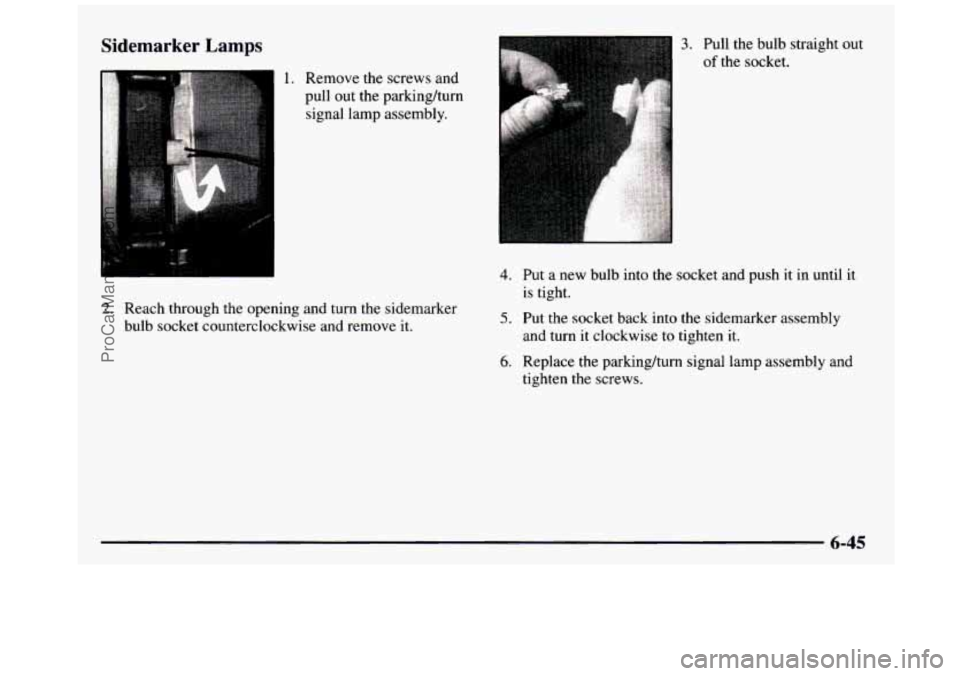
Sidemarker Lamps
1. Remove the screws and
pull out the parkinghum
signal lamp assembly.
2. Reach through the opening and turn the sidemarker
bulb socket counterclockwise and remove
it.
3. Pull the bulb straight out
of the socket.
4. Put a new bulb into the socket and push it in until it
is tight.
5. Put the socket back into the sidemarker assembly
and turn it clockwise to tighten it.
6. Replace the parkinghurn signal lamp assembly and
tighten the screws.
ProCarManuals.com
Page 322 of 436
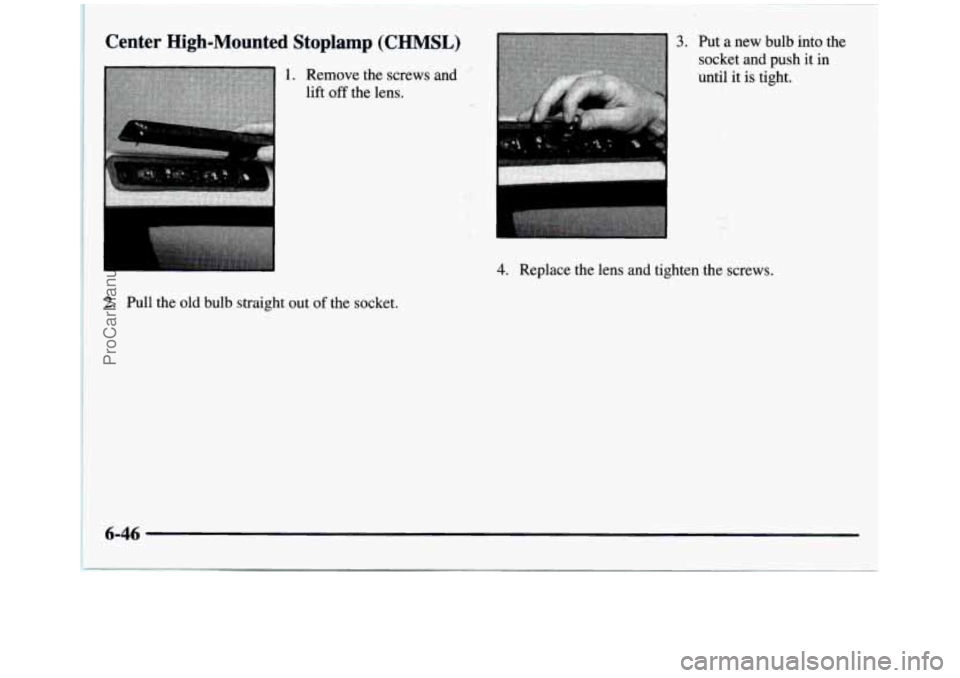
Center High-Mounted Stoplamp (CHMSL)
2. Pull the old bulb straight out of the socket.
I
4. Replace the lens and tighten the screws.
6-46
ProCarManuals.com
Page 323 of 436
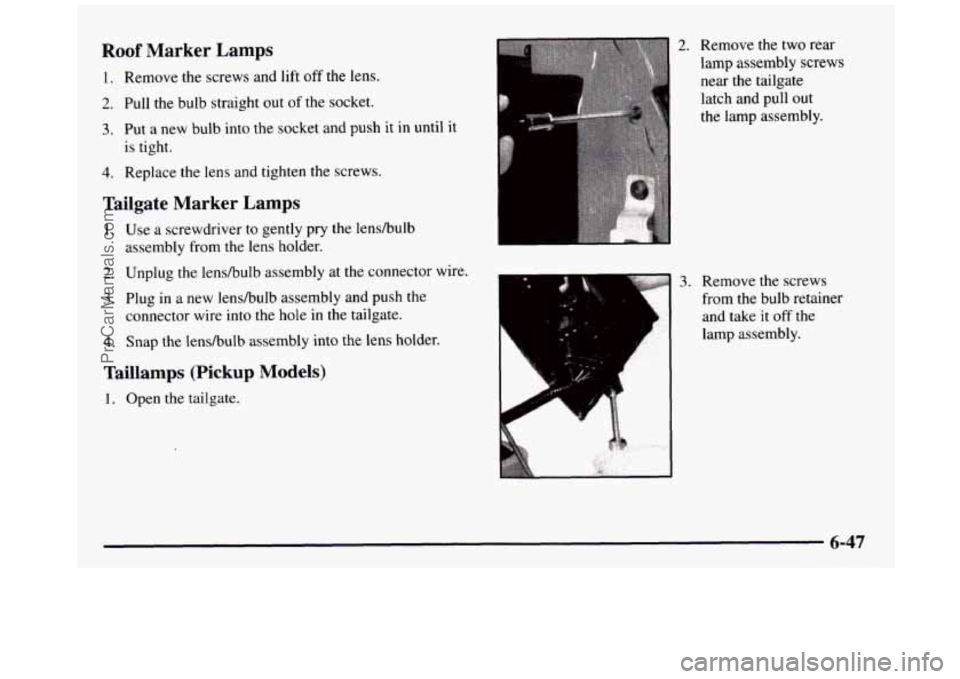
Roof Marker Lamps
1. Remove the screws and lift off the lens.
2. Pull the bulb straight out of the socket.
3. Put a new bulb into the socket and push it in until it
is tight.
4. Replace the lens and tighten the screws.
Tailgate Marker Lamps
1. Use a screwdriver to gently pry the lensbulb
assembly from the lens holder.
2. Unplug the lensbulb assembly at the connector wire.
3. Plug in a new lensbulb assembly and push the
connector wire into the hole in the tailgate.
4. Snap the lensbulb assembly into the lens holder.
Taillamps (Pickup Models)
1. Open the tailgate.
n
2. Remove the two rear
lamp assembly screws
near the tailgate
latch and pull
out
the lamp assembly.
3. Remove the screws
from the bulb retainer
and take it off the lamp assembly.
ProCarManuals.com
Page 324 of 436
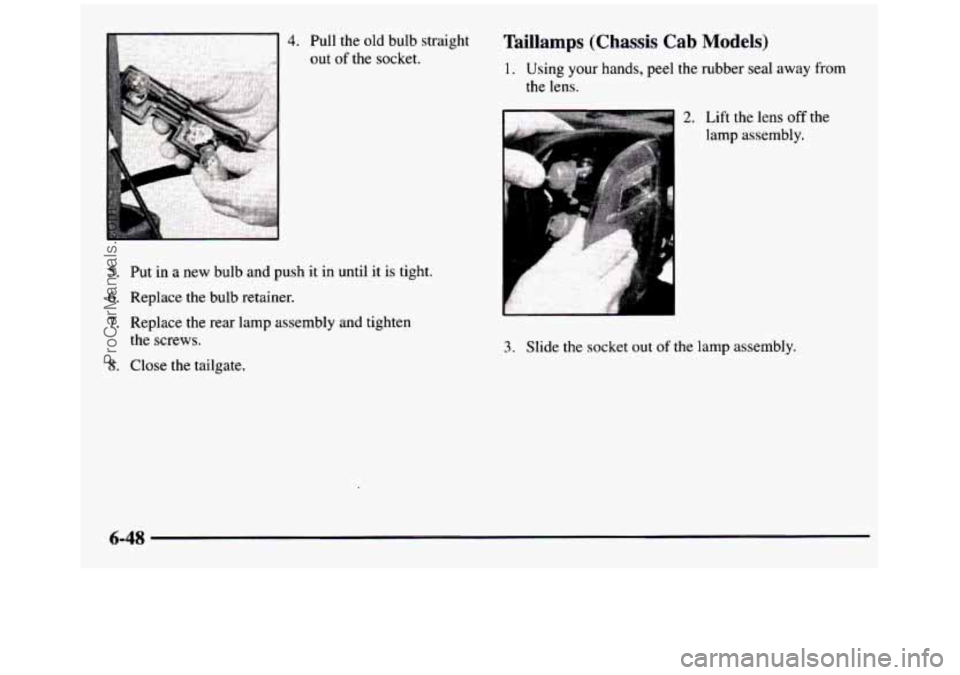
4. Pull the old bulb straight
out
of the socket.
5. Put in a new bulb and push it in until it is tight.
6. Replace the bulb retainer.
7. Replace the rear lamp assembly and tighten
8. Close the tailgate. the screws.
Taillamps (Chassis Cab Models)
1. Using your hands, peel the rubber seal away from
the lens.
2. Lift the lens off the lamp assembly.
P
3. Slide the socket out of the lamp assembly.
6-48
ProCarManuals.com
Page 325 of 436
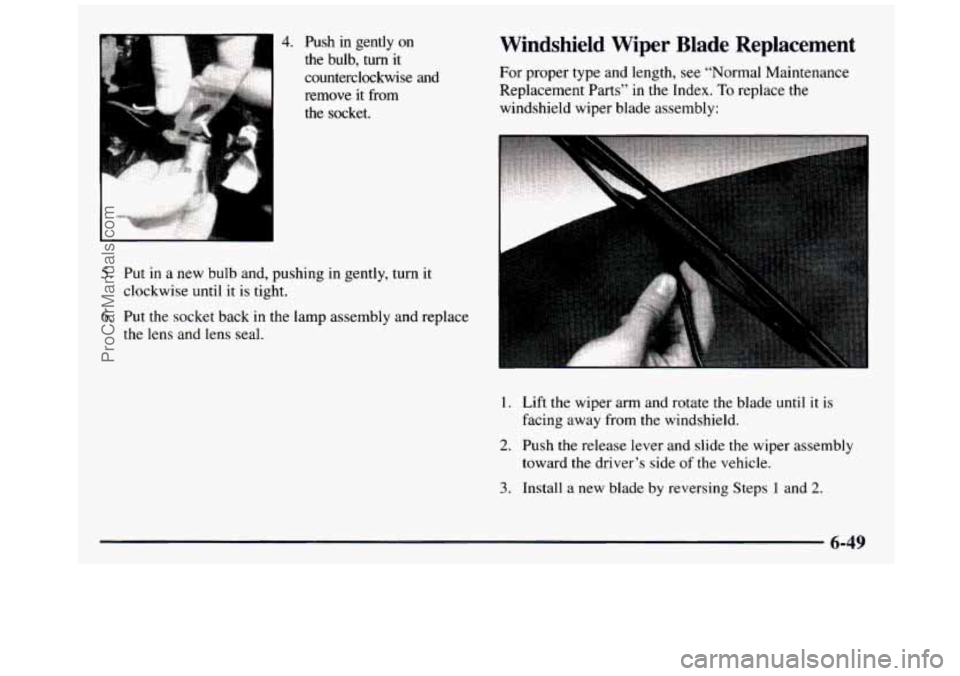
d
i”
4. Push in gently on
the bulb,
turn it
counterclockwise and
remove it from
the socket.
5. Put in a new bulb and, pushing in gently, turn it
clockwise until it is tight.
6. Put the socket back in the lamp assembly and replace
the
lens and lens seal.
Windshield Wiper Blade Replacement
For proper type and length, see “Normal Maintenance
Replacement Parts”
in the Index. To replace the
windshield wiper blade assembly:
I A
I
IA
I
1. Lift the wiper arm and rotate the blade until it is
2. Push the release lever and slide the wiper assembly
facing away from the windshield.
toward
the driver’s
side of the vehicle.
3. Install a new blade by reversing Steps 1 and 2.
ProCarManuals.com
Page 326 of 436
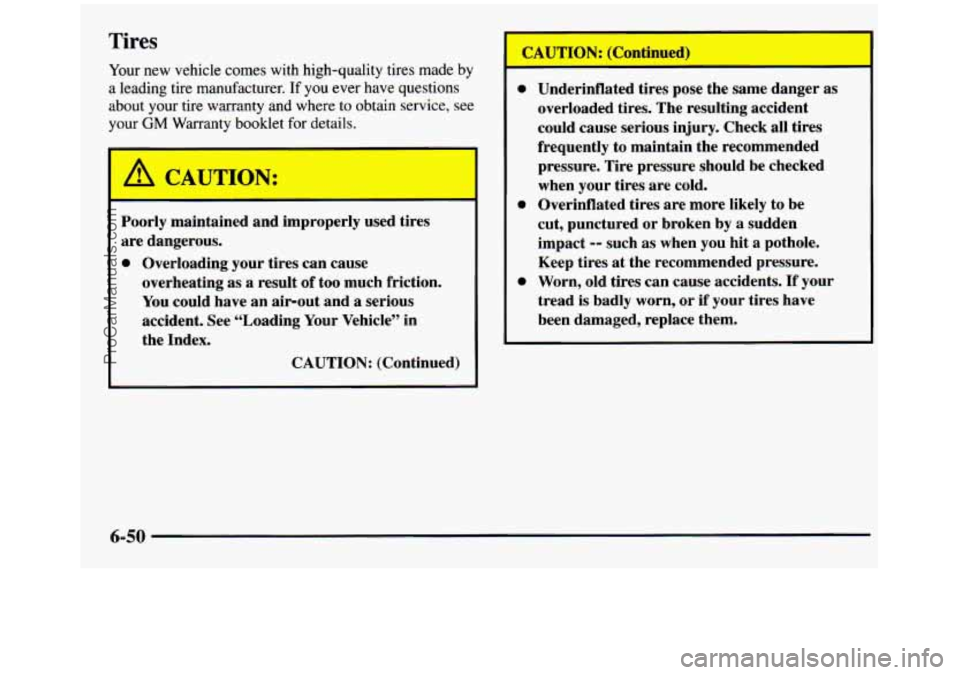
Tires
Your new vehicle comes with high-quality tires made by
a leading tire manufacturer.
If you ever have questions
about your tire warranty and where to obtain service, see
your
GM Warranty booklet for details.
-
A CAUTION:
Poorly maintained and improperly used tires
are dangerous.
0 Overloading your tires can cause
overheating
as a result of too much friction.
You could have an air-out and a serious
accident. See “Loading Your Vehicle” in
the Index.
CAUTION: (Continued)
0 Underinflated tires pose the same danger as
overloaded tires. The resulting accident
could cause serious injury. Check all tires
frequently to maintain the recommended pressure. Tire pressure should be checked
when your tires are cold.
cut, punctured or broken by a sudden
impact
-- such as when you hit a pothole.
Keep tires at the recommended pressure.
0 Worn, old tires can cause accidents. If your
tread
is badly worn, or if your tires have
been damaged, replace them.
0 Overinflated tires are more likely to be
6-50
ProCarManuals.com
Page 327 of 436

Inflation -- Tire Pressure
The Certificationmire label, which is on the rear edge of
the driver’s door, or on the incomplete vehicle document
in the cab, shows the correct inflation pressures for your
tires when they’re cold. “Cold” means your vehicle has
been sitting for at least three hours or driven no more
than
1 mile (1.6 km).
You can operate some vehicles at reduced inflation
pressures only when you’ll be carrying reduced loads.
On those vehicles, the minimum cold inflation pressures
for
a typical reduced load are printed on the Improved
Ride Tire Pressure label located on the driver’s door.
Weigh the vehicle to find the load on each tire and see
the label for the minimum cold inflation pressures for
that load.
NOTICE:
Don’t let anyone tell you that underinflation or
overinflation is all right.
It’s not. If your tires
don’t have enough air (underinflation), you can
get the following:
Too much flexing
Too much heat
0 Tire overloading
Bad wear
Bad handling
Bad fuel economy.
If your tires have too much air (overinflation),
you can get the following:
Unusual wear
Bad handling
Rough ride
Needless damage from road hazards.
6-51
-
ProCarManuals.com
Page 328 of 436
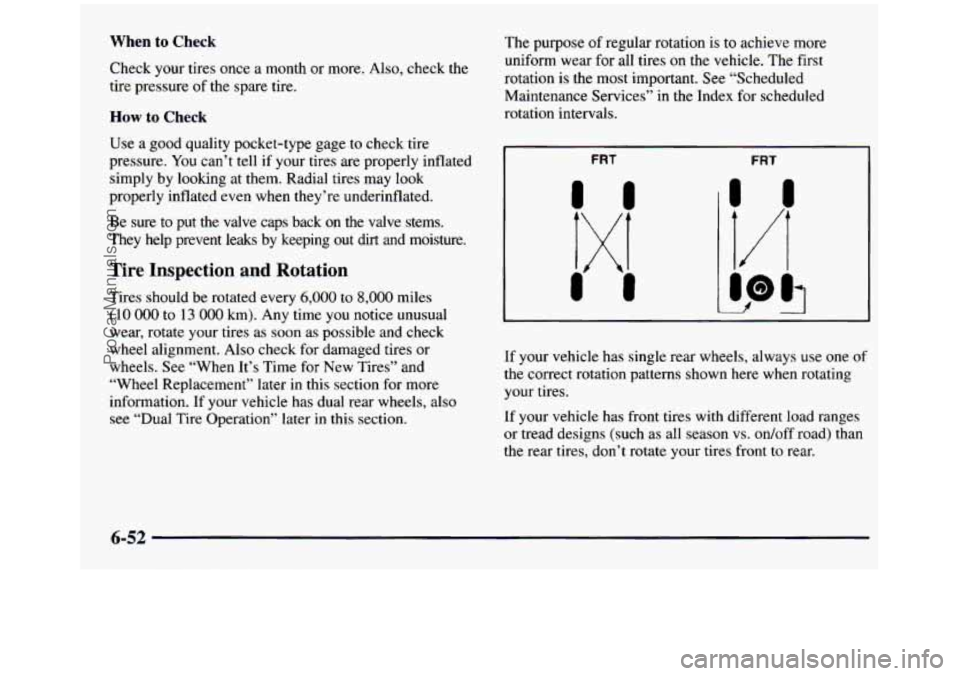
When to Check
Check your tires once a month or more. Also, check the
tire pressure of the spare tire.
How to Check
Use a good quality pocket-type gage to check tire
pressure.
You can’t tell if your tires are properly inflated
simply by looking at them. Radial tires may look
properly inflated even when they’re underinflated.
Be sure
to put the valve caps back on the valve stems.
They help prevent leaks by keeping out
dirt and moisture.
Tire Inspection and Rotation
Tires should be rotated every 6,000 to 8,000 miles
(10 000 to 13 000 km). Any time you notice unusual
wear, rotate your tires as soon as possible and check
wheel alignment.
Also check for damaged tires or
wheels. See “When It’s Time for New Tires” and
“Wheel Replacement” later
in this section for more
information. If your vehicle has dual rear wheels, also
see “Dual Tire Operation” later in this section. The
purpose of regular rotation is to achieve more
uniform wear for all tires
on the vehicle. The first
rotation is the most important. See “Scheduled
Maintenance Services” in the Index for scheduled
rotation intervals.
I FRT FRT
I
If your vehicle has single rear wheels, always use one of
the correct rotation patterns shown here when rotating
your tires.
If your vehicle has front tires with different load ranges
or tread designs (such as all season vs. odoff road)
than
the rear tires, don’t rotate your tires front to rear.
6-52
ProCarManuals.com
Page 329 of 436
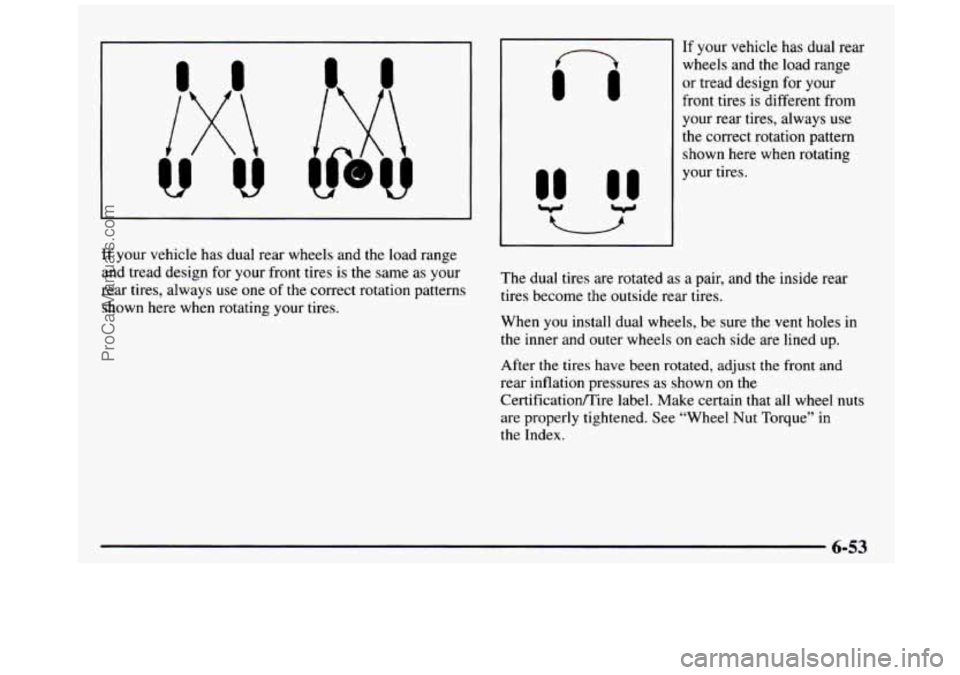
111
V
n
111
If your vehicle has dual rear
wheels and the load range
or tread design for your
front tires is different from
your rear tires, always use
the correct rotation pattern
shown here
when rotating
your tires.
If your vehicle has dual rear wheels and the load range
and tread design for your front tires is the same as your
rear tires, always use one of the correct rotation patterns
shown here when rotating your tires. The dual tires are rotated as
a pair, and the inside rear
tires become the outside rear tires.
When you install dual wheels, be sure the vent holes
in
the inner and outer wheels on each side are lined up.
After the tires have been rotated,
adjust the front and
rear inflation pressures as shown on the
Certificatiomire label. Make certain that all wheel nuts
are properly tightened. See “Wheel Nut Torque” in
the Index.
ProCarManuals.com
Page 330 of 436
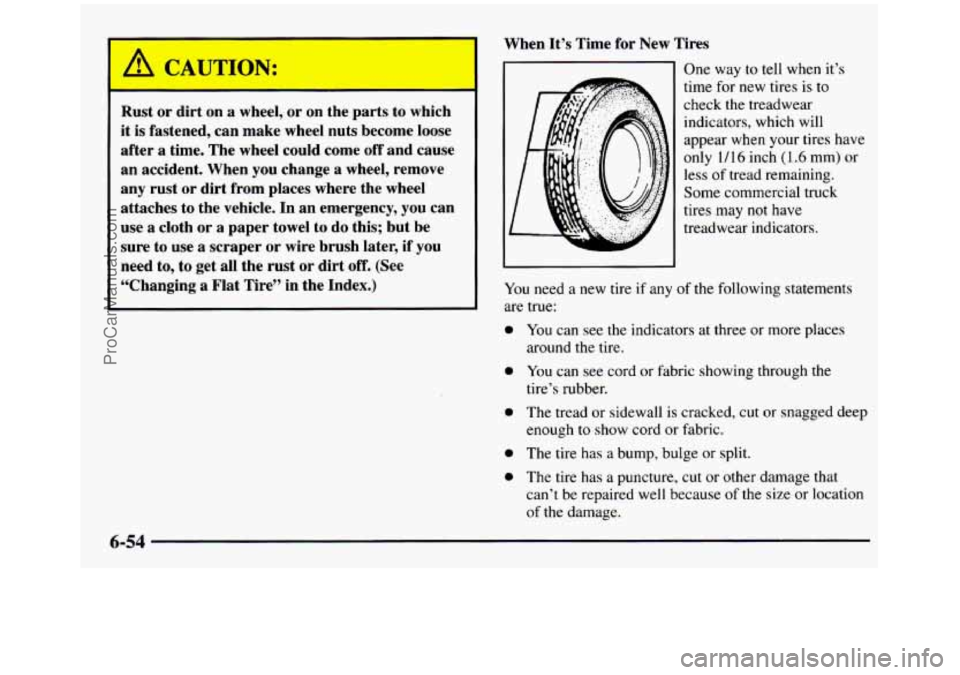
When It’s Time for New Tires
Rust or dirt
on a wheel, or on the parts to which
it is fastened, can make wheel nuts become loose
after a time. The wheel could come
off and cause
an accident. When you change a wheel, remove
any rust
or dirt from places where the wheel
attaches to the vehicle. In an emergency, you can
use a cloth or
a paper towel to do this; but be
sure to use
a scraper or wire brush later, if you
need to,
to get all the rust or dirt off. (See
“Changing
a Flat Tire” in the Index.)
One way to tell when it’s
time for new tires is to
check the treadwear
indicators, which will
appear when your tires have
only 1/16 inch
(1.6 mm) or
less of tread remaining.
Some commercial truck
tires may not have
treadwear indicators.
You need a new tire if any of the following statements
are true:
0 You can see the indicators at three or more places
around the tire.
0 You can see cord or fabric showing through the
0 The tread or sidewall is cracked, cut or snagged deep
tire’s rubber.
enough
to show cord
or fabric.
0 The tire has a bump, bulge or split.
0 The tire has a puncture, cut or other damage that
can’t be repaired well because
of the size or location
of the damage.
6-54
ProCarManuals.com